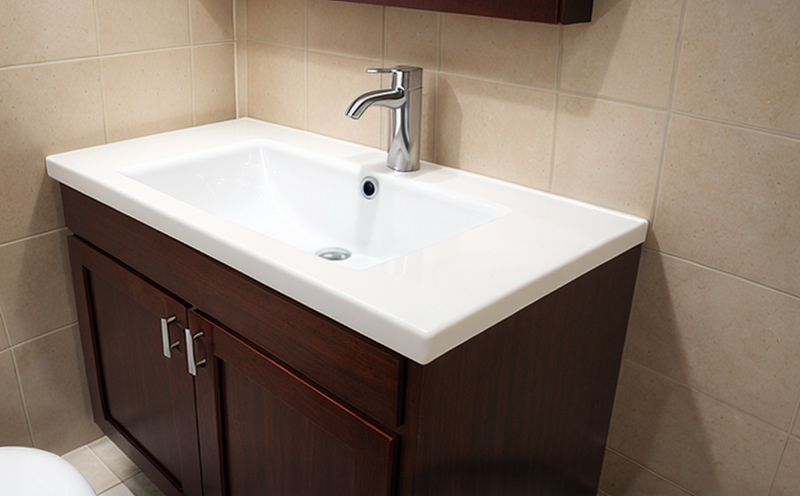EN 997 Performance Testing of Plastic WC Pans
The EN 997 standard is a European Norm that specifies performance requirements and test methods for plastic water closet (WC) pans. This service ensures compliance with stringent specifications to guarantee the quality, durability, and safety of sanitary fixtures. Quality managers, compliance officers, R&D engineers, and procurement professionals rely on this testing to ensure their products meet market demands and regulatory standards.
Plastic WC pans are subjected to a range of tests under EN 997 to evaluate various performance metrics including load-bearing capacity, water resistance, chemical stability, and dimensional accuracy. The load test assesses the pan's ability to withstand specified loads without structural failure. Water resistance ensures that the plastic material can maintain its integrity when exposed to moisture over extended periods.
Chemical stability is crucial as it confirms that the plastic will not degrade or leach harmful substances into water, which could affect hygiene and health standards. Dimensional accuracy tests verify that the manufactured WC pans adhere closely to specified dimensions, ensuring compatibility with existing plumbing systems and fixtures.
The testing process involves rigorous specimen preparation where samples are fabricated according to EN 997 guidelines. Specimens are then subjected to a series of tests using specialized equipment such as load testers, water resistance chambers, and dimensional measurement tools. The results from these tests provide critical insights into the performance characteristics of plastic WC pans.
The testing procedure is designed to replicate real-world conditions under which the products will be used. For instance, the load-bearing capacity test simulates the weight distribution expected in a bathroom setting over time. Water resistance tests involve submerging specimens in water for extended periods to assess their integrity and durability against moisture exposure.
Chemical stability is evaluated by exposing samples to various chemical agents that mimic potential household cleaning products or environmental conditions. Dimensional accuracy checks ensure precise manufacturing tolerances, which are essential for seamless integration into existing plumbing systems. Compliance with EN 997 ensures that the plastic WC pans meet stringent quality standards and contribute to a safer and more hygienic bathroom environment.
Understanding the key parameters of this test is vital for those in the sanitary goods industry. By adhering to these standards, manufacturers can ensure their products are reliable, safe, and compatible with international standards. This testing not only enhances product quality but also boosts consumer confidence and market competitiveness.
Why It Matters
The importance of EN 997 performance testing cannot be overstated in the bathroom & sanitary plastics sector. Compliance with this standard ensures that plastic WC pans meet stringent international requirements, thereby enhancing product reliability and safety. This testing process helps manufacturers identify potential issues early on, allowing for necessary adjustments to improve product quality.
By ensuring compliance with EN 997, companies can demonstrate their commitment to high-quality standards, which is crucial in maintaining a positive brand image and customer trust. The rigorous testing process also helps in identifying areas of improvement, leading to enhanced durability and performance of the products. This, in turn, translates into satisfied customers and increased market share.
Moreover, compliance with international standards like EN 997 can open doors for global markets and collaborations. It ensures that products are accepted and recognized across different countries, facilitating smoother trade and business operations. For R&D engineers and quality managers, this testing is a critical tool in refining product design and ensuring regulatory conformity.
For procurement professionals, the importance of EN 997 performance testing lies in its ability to select suppliers who meet high-quality standards. This ensures that the materials and components used are reliable and consistent with global benchmarks. By focusing on compliance with this standard, procurement teams can enhance their supply chain efficiency and quality assurance processes.
In summary, EN 997 performance testing is vital for ensuring product reliability, safety, and international acceptance. It plays a pivotal role in enhancing brand reputation, fostering innovation, and supporting global business operations. For professionals in the sanitary goods industry, this testing process is indispensable in meeting stringent regulatory requirements and delivering high-quality products.
Applied Standards
| Standard | Description |
|---|---|
| EN 997-1 | Performance requirements for plastic water closet pans |
| EN 997-2 | Test methods for plastic water closet pans |
| ISO 10653 | Dimensional tolerances for plumbing fixtures |
| ASTM F1874 | Standard test method for determining water resistance of sanitary ware products |
The EN 997 standard is complemented by other internationally recognized standards such as ISO 10653 and ASTM F1874. These additional standards provide a comprehensive framework that ensures the quality, safety, and reliability of plastic WC pans in the bathroom & sanitary sector.
International Acceptance and Recognition
- European Union: EN 997 is widely accepted across EU countries as a benchmark for plastic WC pan performance.
- United Kingdom: UK regulations often align with EN standards, making compliance crucial for manufacturers exporting to the UK market.
- Australia & New Zealand: While not directly adopting EN 997, similar performance requirements are specified in AS/NZS 3504:2016, which is designed to be compatible with international standards like EN 997.
- United States: Although the U.S. does not have a direct equivalent to EN 997, many American manufacturers and importers adhere to similar performance criteria to ensure product compatibility and safety.
The acceptance of EN 997 in various global markets underscores its significance as an industry standard. Compliance with this standard ensures that plastic WC pans meet the stringent requirements set by international regulatory bodies, thereby enhancing their marketability and acceptance worldwide.





